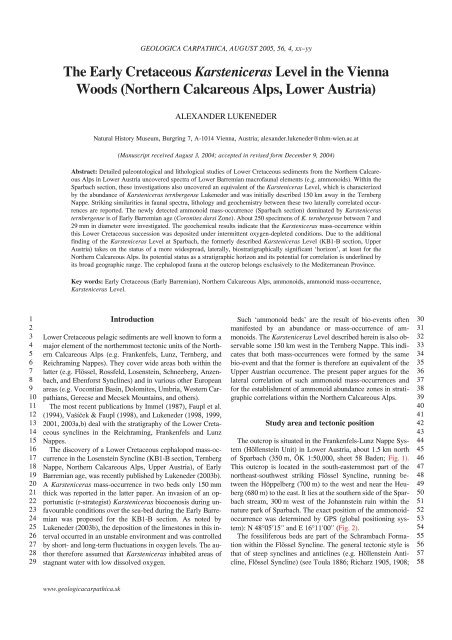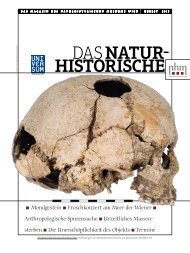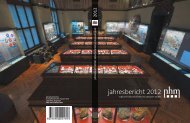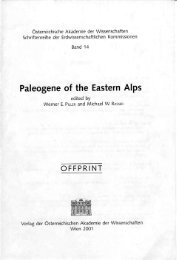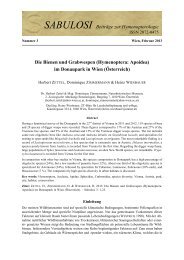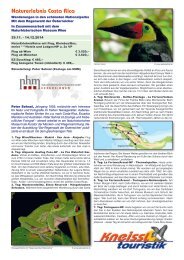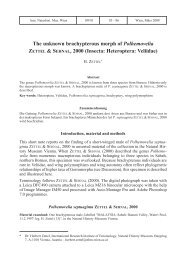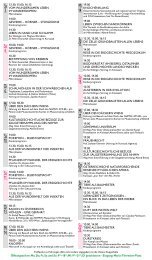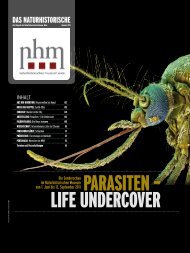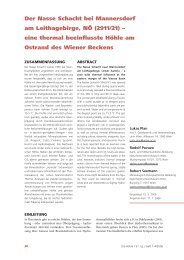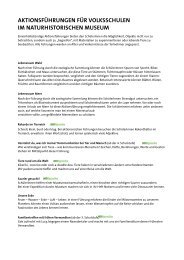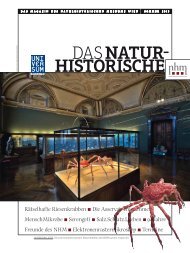Lukeneder pdf - Naturhistorisches Museum Wien
Lukeneder pdf - Naturhistorisches Museum Wien
Lukeneder pdf - Naturhistorisches Museum Wien
You also want an ePaper? Increase the reach of your titles
YUMPU automatically turns print PDFs into web optimized ePapers that Google loves.
1<br />
2<br />
3<br />
4<br />
5<br />
6<br />
7<br />
8<br />
9<br />
10<br />
11<br />
12<br />
13<br />
14<br />
15<br />
16<br />
17<br />
18<br />
19<br />
20<br />
21<br />
22<br />
23<br />
24<br />
25<br />
26<br />
27<br />
28<br />
29<br />
www.geologicacarpathica.sk<br />
GEOLOGICA CARPATHICA, AUGUST 2005, 56, 4, xx–yy<br />
The Early Cretaceous Karsteniceras Level in the Vienna<br />
Woods (Northern Calcareous Alps, Lower Austria)<br />
ALEXANDER LUKENEDER<br />
Natural History <strong>Museum</strong>, Burgring 7, A-1014 Vienna, Austria; alexander.lukeneder@nhm-wien.ac.at<br />
(Manuscript received August 3, 2004; accepted in revised form December 9, 2004)<br />
Abstract: Detailed paleontological and lithological studies of Lower Cretaceous sediments from the Northern Calcareous<br />
Alps in Lower Austria uncovered spectra of Lower Barremian macrofaunal elements (e.g. ammonoids). Within the<br />
Sparbach section, these investigations also uncovered an equivalent of the Karsteniceras Level, which is characterized<br />
by the abundance of Karsteniceras ternbergense <strong>Lukeneder</strong> and was initially described 150 km away in the Ternberg<br />
Nappe. Striking similarities in faunal spectra, lithology and geochemistry between these two laterally correlated occurrences<br />
are reported. The newly detected ammonoid mass-occurrence (Sparbach section) dominated by Karsteniceras<br />
ternbergense is of Early Barremian age (Coronites darsi Zone). About 250 specimens of K. ternbergense between 7 and<br />
29 mm in diameter were investigated. The geochemical results indicate that the Karsteniceras mass-occurrence within<br />
this Lower Cretaceous succession was deposited under intermittent oxygen-depleted conditions. Due to the additional<br />
finding of the Karsteniceras Level at Sparbach, the formerly described Karsteniceras Level (KB1-B section, Upper<br />
Austria) takes on the status of a more widespread, laterally, biostratigraphically significant ‘horizon’, at least for the<br />
Northern Calcareous Alps. Its potential status as a stratigraphic horizon and its potential for correlation is underlined by<br />
its broad geographic range. The cephalopod fauna at the outcrop belongs exclusively to the Mediterranean Province.<br />
Key words: Early Cretaceous (Early Barremian), Northern Calcareous Alps, ammonoids, ammonoid mass-occurrence,<br />
Karsteniceras Level.<br />
Introduction<br />
Lower Cretaceous pelagic sediments are well known to form a<br />
major element of the northernmost tectonic units of the Northern<br />
Calcareous Alps (e.g. �rankenfels, Lunz, Ternberg, and<br />
Reichraming Nappes). They cover wide areas both within the<br />
latter (e.g. �lössel, Rossfeld, Losenstein, Schneeberg, Anzenbach,<br />
and Ebenforst Synclines) and in various other European<br />
areas (e.g. Vocontian Basin, Dolomites, Umbria, Western Carpathians,<br />
Gerecse and Mecsek Mountains, and others).<br />
The most recent publications by Immel (1987), �aupl et al.<br />
(1994), Vašíèek & �aupl (1998), and <strong>Lukeneder</strong> (1998, 1999,<br />
2001, 2003a,b) deal with the stratigraphy of the Lower Cretaceous<br />
synclines in the Reichraming, �rankenfels and Lunz<br />
Nappes.<br />
The discovery of a Lower Cretaceous cephalopod mass-occurrence<br />
in the Losenstein Syncline (KB1-B section, Ternberg<br />
Nappe, Northern Calcareous Alps, Upper Austria), of Early<br />
Barremian age, was recently published by <strong>Lukeneder</strong> (2003b).<br />
A Karsteniceras mass-occurrence in two beds only 150 mm<br />
thick was reported in the latter paper. An invasion of an opportunistic<br />
(r-strategist) Karsteniceras biocoenosis during unfavourable<br />
conditions over the sea-bed during the Early Barremian<br />
was proposed for the KB1-B section. As noted by<br />
<strong>Lukeneder</strong> (2003b), the deposition of the limestones in this interval<br />
occurred in an unstable environment and was controlled<br />
by short- and long-term fluctuations in oxygen levels. The author<br />
therefore assumed that Karsteniceras inhabited areas of<br />
stagnant water with low dissolved oxygen.<br />
Such ‘ammonoid beds’ are the result of bio-events often<br />
manifested by an abundance or mass-occurrence of ammonoids.<br />
The Karsteniceras Level described herein is also observable<br />
some 150 km west in the Ternberg Nappe. This indicates<br />
that both mass-occurrences were formed by the same<br />
bio-event and that the former is therefore an equivalent of the<br />
Upper Austrian occurrence. The present paper argues for the<br />
lateral correlation of such ammonoid mass-occurrences and<br />
for the establishment of ammonoid abundance zones in stratigraphic<br />
correlations within the Northern Calcareous Alps.<br />
Study area and tectonic position<br />
The outcrop is situated in the �rankenfels-Lunz Nappe System<br />
(Höllenstein Unit) in Lower Austria, about 1.5 km north<br />
of Sparbach (350 m, ÖK 1:50,000, sheet 58 Baden; �ig. 1).<br />
This outcrop is located in the south-easternmost part of the<br />
northeast-southwest striking �lössel Syncline, running between<br />
the Höppelberg (700 m) to the west and near the Heuberg<br />
(680 m) to the east. It lies at the southern side of the Sparbach<br />
stream, 300 m west of the Johannstein ruin within the<br />
nature park of Sparbach. The exact position of the ammonoidoccurrence<br />
was determined by GPS (global positioning system):<br />
N 48°05’15’’ and E 16°11’00’’ (�ig. 2).<br />
The fossiliferous beds are part of the Schrambach �ormation<br />
within the �lössel Syncline. The general tectonic style is<br />
that of steep synclines and anticlines (e.g. Höllenstein Anticline,<br />
�lössel Syncline) (see Toula 1886; Richarz 1905, 1908;<br />
30<br />
31<br />
32<br />
33<br />
34<br />
35<br />
36<br />
37<br />
38<br />
39<br />
40<br />
41<br />
42<br />
43<br />
44<br />
45<br />
46<br />
47<br />
48<br />
49<br />
50<br />
51<br />
52<br />
53<br />
54<br />
55<br />
56<br />
57<br />
58
59<br />
60<br />
61<br />
62<br />
63<br />
64<br />
65<br />
66<br />
67<br />
68<br />
69<br />
70<br />
71<br />
72<br />
73<br />
74<br />
75<br />
2 LUKENEDER<br />
Article in Proof<br />
�ig. 1. Sketch map of the excavation site N of Sparbach. The Upper<br />
Austroalpine Northern Calcareous Alps extend from the Austrian<br />
western border to the city area of Vienna. The white square indicates<br />
the geological area of the sketch map below. Sketch map of the NE<br />
spur of the Northern Calcareous Alps: WB — Vienna Basin, GB —<br />
Gaadener Basin; �lysch Zone: KA — Kahlenberg Ridge, SA —<br />
Satzberg Ridge; �rankenfels–Lunz Nappe System: K — Kalksburger<br />
Unit, H — Höllenstein Unit, � — �öhrenberg Wasserspreng Unit;<br />
Ötscher Nappe System: KB — Kalenderberg Scale, AN — Anninger<br />
Scale, RE — Rauheneck Scale (scale 1:400,000). Map after<br />
ÖK 1:50,000, sheet 58 Baden (Geological Survey Vienna, 1997).<br />
White square indicates the area of sketch map �ig. 2.<br />
Spitz 1910; Schwinghammer 1975). The �lössel Syncline is<br />
formed of Upper Triassic dolomite, followed by a reduced Jurassic<br />
sequence (see also Rosenberg 1965; Plöchinger & Prey<br />
1993). The core of the �lössel Syncline consists of the Lower<br />
Cretaceous Schrambach �ormation, which occurs throughout<br />
the Northern Calcareous Alps. Within the Lunz Nappe the<br />
Schrambach �ormation comprises Upper Valanginian to Lower<br />
Barremian sediments.<br />
Material and ammonoid fauna<br />
Bed-by-bed collecting and a systematic-taxonomic study<br />
provide the basic data for statistical analysis of the investigated<br />
ammonite faunas. Paleontological and paleoecological investigations,<br />
combined with studies of lithofacies in thin sections,<br />
peels from polished rock surfaces and geochemical<br />
investigations, yielded information about the environmental<br />
conditions in the area of deposition.<br />
Carefully selected and washed samples of distinct laminated<br />
limestones contain primarily fine silt-sized, angular quartz<br />
grains, some pyrite and phosphatic material (fish scales, teeth<br />
and bones, ichthyoliths). The rare, generally poorly preserved<br />
micro-invertebrate fauna consists of a few arenaceous fora-<br />
�ig. 2. Geological situation and sediments of the �lössel Syncline<br />
with indicated position of the Sparbach locality.<br />
76<br />
77<br />
78<br />
79<br />
80<br />
81<br />
82<br />
83<br />
84<br />
85<br />
86<br />
87<br />
88<br />
89<br />
90<br />
91<br />
92<br />
93<br />
94
95<br />
96<br />
97<br />
98<br />
99<br />
100<br />
101<br />
102<br />
103<br />
104<br />
105<br />
106<br />
107<br />
108<br />
109<br />
110<br />
111<br />
112<br />
113<br />
114<br />
115<br />
116<br />
117<br />
118<br />
119<br />
120<br />
121<br />
122<br />
THE EARLY CRETACEOUS KARSTENICERAS LEVEL IN THE VIENNA WOODS 3<br />
�ig. 3. The locality with indicated position of the Karsteniceras Level (K1–K2). On the right side, two longitudinal scans of the<br />
polished surface of the beds 0–2c from the abundance beds. Note the indistinct lamination of beds 1a–2a. Beds 2b and 2c are not<br />
laminated due to bioturbation. Black arrows indicate positions of limonitic specimens of Karsteniceras.<br />
minifers (planktonic), radiolarians, ostracods, and sponge spicules<br />
(investigated in thin sections).<br />
The macrofauna from bed K1 (beds 1–2; samples 1a–2c)<br />
and K2 (bed A; sample Aa) (�igs. 3 and 4) is predominated by<br />
sculpture-moulds of cephalopods. The poorly preserved limonitic<br />
ammonite moulds are accompanied by a single lamellaptychus-like<br />
ammonoid jaw.<br />
Article in Proof<br />
Six genera of Ammonitina and Ancyloceratina (suborders),<br />
comprising 3 different species, are reported in this paper. The<br />
cephalopod fauna at the outcrop covers exclusively forms of<br />
the Mediterranean Province, which are typical for the Northern<br />
Calcareous Alps. The cephalopods can be found in the<br />
whole sequence but seem to be concentrated at a certain level.<br />
About 250 specimens of Karsteniceras ternbergense between<br />
7 and 29 mm in diameter were investigated (122 specimens<br />
were measured). Most of the specimens are observable<br />
on one side only; they are entire and show no fragmentation.<br />
Juvenile stages and the ventral area can be observed in just a<br />
few specimens. The very abundant small heteromorphs are<br />
generally poorly preserved. Their casts (sculpture moulds),<br />
with perfectly preserved sculpture, are usually pyritized. The<br />
current paper follows the classification of the Cretaceous Ammonoidea<br />
summarized by Wright et al. (1996).<br />
The Karsteniceras Level at Sparbach yields important ammonoid<br />
taxa such as Eulytoceras sp., Barremites (Barremites)<br />
cf. difficilis (d’Orbigny, 1841), Pulchellia sp., Holcodiscus<br />
sp., Anahamulina cf. subcincta (Uhlig, 1883) and Karsteniceras<br />
ternbergense <strong>Lukeneder</strong> (in <strong>Lukeneder</strong> et Tanabe, 2002).<br />
The cephalopod fauna is accompanied by aptychi (Lamellaptychus)<br />
and bivalves (Propeamusium) (�igs. 5 and 6).<br />
The analysis of the fauna supports the interpretation of a<br />
soft to level bottom paleoenvironment with a cephalopoddominated<br />
community living near the epicontinental (epeiric)<br />
sea floor.<br />
Lithology of the Karsteniceras Level<br />
The Lower Cretaceous Schrambach �ormation is a sequence<br />
of deep-water limestones and marls marked by rhythmically<br />
intercalated turbiditic sandstones, sedimented under<br />
relatively deep-water conditions. A short-term sedimentation<br />
is proposed for the sandstone layers, whereas the limestoneand<br />
marl-beds reflect ‘normal’ sedimentation rates.<br />
Dark marls and grey, spotted limestones are highly bioturbated<br />
biogenic mudstones to wackestones. The occurrence of<br />
chrome spinel supports the correlation with the turbiditic intercalations<br />
in the Schrambach �ormation of the Reichraming<br />
Nappe (Upper Austria), a western equivalent of the Lunz<br />
Nappe, and supports the interpretation that the sandstone in-<br />
123<br />
124<br />
125<br />
126<br />
127<br />
128<br />
129<br />
130<br />
131<br />
132<br />
133<br />
134<br />
135<br />
136<br />
137<br />
138<br />
139<br />
140<br />
141<br />
142<br />
143<br />
144<br />
145<br />
146<br />
147
148<br />
149<br />
150<br />
151<br />
152<br />
153<br />
154<br />
155<br />
156<br />
157<br />
158<br />
159<br />
160<br />
161<br />
4 LUKENEDER<br />
Article in Proof<br />
�ig. 4. �auna and position of the Karsteniceras Level within the log (Schrambach �ormation).<br />
tercalations are derived from a more southerly situated landswell<br />
(Vašíèek et al. 1994).<br />
The calcium carbonate contents within the Karsteniceras<br />
Level (K1 and K2; �ig. 4) (CaCO 3 equivalents calculated<br />
from total inorganic carbon) vary between 73 and 83 %. The<br />
wt. % TOC (Total Organic Carbon) values vary between 0.03<br />
and 0.52 %. Sulphur ranges from 0.27 to 0.57 mg/g (�ig. 7).<br />
The distinct-laminated appearance of the rock is a result of<br />
wispy, discontinuous, flaser-like laminae of dark (organic)<br />
material and some sorting of radiolarian tests into the layers.<br />
Many of these tests have been partly to completely replaced<br />
by pyrite (secondarily limonitic) in a micritic carbonate matrix.<br />
Pyritized radiolarians seem to be predominantly preserved<br />
around ammonoid tests. This could be due to the al-<br />
tered ‘micro-environment’, specifically the higher organic<br />
content (soft-body). The laminae range in thickness from<br />
0.07–0.1 mm to 0.7–2.4 mm. Contacts between them are gradational<br />
to sharp. Phosphatic debris is abundant and consists<br />
mainly of fish scales, bones and teeth. Laminated brown-black<br />
mudstone is rich in organic carbon. Dark material is wispy<br />
amorphous organic matter. Pale areas are laminae of flattened<br />
radiolaria now replaced by microcrystalline chalcedony.<br />
Systematic paleontology<br />
Conventions: The standard dimensions for Karsteniceras<br />
ternbergense are given in millimeters. The following abbrevi-<br />
162<br />
163<br />
164<br />
165<br />
166<br />
167<br />
168<br />
169<br />
170<br />
171<br />
172<br />
173<br />
174<br />
175
176<br />
177<br />
178<br />
179<br />
180<br />
181<br />
182<br />
183<br />
184<br />
185<br />
186<br />
187<br />
188<br />
189<br />
190<br />
191<br />
192<br />
193<br />
194<br />
195<br />
196<br />
197<br />
198<br />
199<br />
200<br />
201<br />
202<br />
203<br />
THE EARLY CRETACEOUS KARSTENICERAS LEVEL IN THE VIENNA WOODS 5<br />
�ig. 5. Ammonoid spectrum from the Sparbach locality. Note the dominance of the genus Karsteniceras (Ancyloceratina). Size distribution<br />
(below) of the species Karsteniceras ternbergense. Conventions: max. D. — shell diameter, max. B. — maximum breadth,<br />
WH — maximum whorl height, NW — umbilicus width, WB — whorl breadth.<br />
ations have been used (�ig. 5): max. D. — shell diameter;<br />
max. B. — maximum breadth; WH — maximum whorl<br />
height; NW — umbilicus width; WB — maximum whorl<br />
breadth; NHMW — <strong>Naturhistorisches</strong> <strong>Museum</strong> <strong>Wien</strong>. The<br />
author follows the classification of the Cretaceous Ammonoidea<br />
by Wright et al. (1996). Only specimens of the species<br />
Karsteniceras ternbergense, which are the dominant element<br />
of the fauna and the eponymous element of the<br />
investigated level, are described systematically herein. The<br />
measurements include only those from almost complete or<br />
well-preserved specimens.<br />
Article in Proof<br />
Order: Ammonoidea Zittel, 1884<br />
Suborder: Ancyloceratina Wiedmann, 1966<br />
Superfamily: Ancylocerataceae Gill, 1871<br />
�amily: Ancyloceratidae Gill, 1871<br />
Subfamily: Leptoceratoidinae Thieuloy, 1966<br />
Genus: Karsteniceras Royo y Gomez, 1945<br />
Type species: Ancyloceras beyrichi Karsten, 1858<br />
Karsteniceras ternbergense <strong>Lukeneder</strong> in <strong>Lukeneder</strong> et<br />
Tanabe, 2002<br />
�ig. 6.7–15<br />
2002 Karsteniceras ternbergense <strong>Lukeneder</strong> — <strong>Lukeneder</strong> et Tanabe,<br />
p. 18, �igs. 3A–C, 5–6<br />
2003b Karsteniceras ternbergense <strong>Lukeneder</strong> — <strong>Lukeneder</strong>, p. 96,<br />
Pl. 10, �igs. 1–13<br />
Material: 250 crushed and mainly limonitic specimens<br />
(sculpture moulds) from the locality near Sparbach, beds K1<br />
and K2 (�igs. 3 and 4). Most specimens are entire and show<br />
no fragmentation. Juvenile stages and the ventral area can be<br />
observed in a few specimens. The suture line is not visible.<br />
The whorl height (WH) varies from 2–7 mm, whereas the<br />
whorl breadth (WB) values are relatively constant from 0.6–<br />
2 mm due to compaction.<br />
Description: The small, criocone shells probably show<br />
weak torsions (trochospiral coiling). The spire becomes criocone<br />
after an advolute embryonal and juvenile stage. Some<br />
specimens become advolute in the middle of one whorl and revert<br />
to a criocone whorl later. A few specimens seem to be advolute<br />
over most of the whorl-distance. The species apparently<br />
has a highly variable coiling (<strong>Lukeneder</strong> 2003b). The sculpture<br />
comprises relative dense, sharp and simple ribs (<strong>Lukeneder</strong><br />
& Tanabe 2002; <strong>Lukeneder</strong> 2003b) intercepted by stronger<br />
main ribs on the body chambers (only visible in few specimens).<br />
The largest specimen reaches a diameter of 39 mm.<br />
Single, sharp, uniform ribs cross the venter without a ventral<br />
depression or furrow. Up to 45–50 single ribs are present on<br />
one whorl. No tubercles occur.<br />
Remarks: Karsteniceras ternbergense differs from all<br />
other descendant species of the genus Karsteniceras in its<br />
clear and distinct main ribs on the body chamber of adult specimens,<br />
different maximum size and number of ribs per whorl<br />
(<strong>Lukeneder</strong> & Tanabe 2002; <strong>Lukeneder</strong> 2003b). A detailed<br />
204<br />
205<br />
206<br />
207<br />
208<br />
209<br />
210<br />
211<br />
212<br />
213<br />
214<br />
215<br />
216<br />
217<br />
218<br />
219<br />
220<br />
221<br />
222<br />
223<br />
224<br />
225<br />
226<br />
227<br />
228<br />
229<br />
230
231<br />
232<br />
233<br />
234<br />
235<br />
236<br />
237<br />
238<br />
239<br />
240<br />
241<br />
242<br />
243<br />
244<br />
245<br />
246<br />
247<br />
248<br />
249<br />
6 LUKENEDER<br />
Article in Proof<br />
�ig. 6. Early Barremian Lytoceratina, Ancyloceratina, aptychi and bivalves from the �lössel Syncline (Schrambach �ormaion). Typical representatives<br />
of the Sparbach assemblage. 1 — Eulytoceras sp.; 2004z00/0001. 2 — Barremites (Barremites) cf. difficilis (d’Orbigny 1841),<br />
2004z00/0002. 3–4 — Pulchellia sp., 2004z00/0003-04. 5 — Holcodiscus sp., 2004z0045/0005. 6–15 — Karsteniceras ternbergense<br />
<strong>Lukeneder</strong> 2002, 2004z0045/0006-15. 16 — Anahamulina cf. subcincta (Uhlig 1883), 2004z00/0016. 17 — Lamellaptychus sp., 2004z00/<br />
0017. 18 — Prepeamusium sp. (bivalve), 2004z00/0018. All specimens were collected at the Sparbach section, coated with ammonium chloride<br />
before photographing and are stored at the <strong>Museum</strong> of Natural History Vienna. Scale bar for 1–16, 18 = 10 mm; for 17 = 2.5 mm.<br />
discussion of the genus Karsteniceras and morphological details<br />
of its members is given in Vašíèek & Wiedmann (1994)<br />
(see also Vašíèek & Klajmon 1998).<br />
Stratigraphic range: Karsteniceras ternbergense has<br />
been found in one level (two beds) of Early Barremian age in<br />
the Sparbach section of the Lunz Nappe (Lower Austria,<br />
Northern Calcareous Alps). Due to the earlier-mentioned<br />
stratigraphically important taxa, the stratigraphic range of<br />
Karsteniceras ternbergense <strong>Lukeneder</strong> is proposed to be the<br />
Coronites darsi Zone (former Moutoniceras moutonianum<br />
Zone) (<strong>Lukeneder</strong> 2003b). The same Karsteniceras Level was<br />
detected and described by <strong>Lukeneder</strong> (2003b) about 150 km<br />
west in the KB1-B section and in rock material from the KB2<br />
section (200 m west of KB1) of the Ternberg Nappe (Upper<br />
Austria, Northern Calcareous Alps). The Karsteniceras balernaense<br />
occurrence (Rieber 1977) in the Barremian of the<br />
Breggia Gorge (south Switzerland) shows some similarities in<br />
the field occurrence, but not in density of specimens.<br />
Biostratigraphy —<br />
the Karsteniceras ‘Abundance Zone’<br />
An abundance zone is a stratum or rock-body in which the<br />
abundance of a particular taxon or specified group of taxa is<br />
significantly greater than is usual in the adjacent parts of the<br />
250<br />
251<br />
252<br />
253<br />
254<br />
255<br />
256<br />
257<br />
258<br />
259<br />
260<br />
261<br />
262
263<br />
264<br />
265<br />
266<br />
267<br />
268<br />
269<br />
270<br />
271<br />
272<br />
273<br />
THE EARLY CRETACEOUS KARSTENICERAS LEVEL IN THE VIENNA WOODS 7<br />
section (Salvador 1994). Its boundaries consist of biohorizons<br />
and the name is given by the abundant taxon or taxa.<br />
Biohorizons are for example characterized by a sharp and<br />
significant biostratigraphic change within the fossil assemblage<br />
and/or a change in the frequency of its members (see<br />
Salvador 1994; Steininger & Piller 1999). Such biohorizons<br />
are of great importance for lateral correlation (see <strong>Lukeneder</strong><br />
2003a).<br />
The presence of abundance zones (‘ammonoid-beds’; characterized<br />
by abundance or mass-occurrence of ammonoids)<br />
seems to be related with sea-level rises or falls (see also Hoe-<br />
Article in Proof<br />
�ig. 7. Geochemical parameters from the Sparbach section within<br />
and around the Karsteniceras Level.<br />
demaeker 1994; Aguirre-Urreta & Rawson 1998, 1999).<br />
Abundance of ammonoids generally occurs in condensed<br />
parts of sediment successions. Condensation occurs at the<br />
maximum flooding levels of depositional sequences (pers.<br />
comm. Hoedemaeker). These abundance zones are of exceptional<br />
value for the interregional correlation in the Early Cretaceous.<br />
�or a review of such Lower Cretaceous ‘uniformitybeds’<br />
formed by a monotonous ammonoid assemblage over at<br />
least a single bed up to a few meters thickness see <strong>Lukeneder</strong><br />
(2003a).<br />
At the Sparbach section, the following ammonoid abundance<br />
zone (characterized by abundance or mass-occurrence<br />
of ammonoids) was detected. The names of the separated beds<br />
reflect the dominating genus or species (�ig. 3).<br />
Karsteniceras-Abundance Zone (Early Barremian), at meter<br />
160, 0.3 m thickness, dark grey, distinctly laminated, marly<br />
limestones, dipping 320/40°, dominated by the occurrence of<br />
Karsteniceras ternbergense (�ig. 6).<br />
The ammonoid association indicates that the cephalopodbearing<br />
beds in the Schrambach �ormation belong to the latest<br />
Early Barremian (e.g. Moutoniceras moutonianum Ammonoid<br />
Zone; according to the results of the Vienna meeting of the<br />
Lower Cretaceous Ammonite Working Group of the IUGS;<br />
Hoedemaeker & Rawson 2000; see also <strong>Lukeneder</strong> 2001)<br />
(�ig. 8). The M. moutonianum Zone was recently replaced<br />
(according to the results of the Lyon meeting of the Lower<br />
Cretaceous Ammonite Working Group of the IUGS) by the<br />
Coronites darsi Zone (Hoedemaeker et al. 2003) (�ig. 8). Due<br />
of its noticeable similarities with the KB1-B occurrence<br />
(Karsteniceras Level; <strong>Lukeneder</strong> 2003b), although Moutoniceras<br />
moutonianum and Coronites darsi are missing, the<br />
typical association hints to the latest Early Barremian.<br />
Sparbach versus KB1-B — differences and affinities<br />
Remarkable similarities between the Sparbach (Lower Austria)<br />
and the KB1-B setion (Upper Austria) are observable in<br />
age, fabric, lithology, thin sections and faunal spectra.<br />
The number and thickness of abundance beds can be correlated<br />
precisely over a distance of more than 150 kilometers.<br />
One of the few apparent differences lies in the geochemical<br />
results. The sulphur and TOC contents within beds of the<br />
�ig. 8. Stratigraphic position within the Early Barremian (C. darsi<br />
Zone) of the Sparbach fauna (in grey). Table modified after Hoedemaeker<br />
et al. (2003).<br />
274<br />
275<br />
276<br />
277<br />
278<br />
279<br />
280<br />
281<br />
282<br />
283<br />
284<br />
285<br />
286<br />
287<br />
288<br />
289<br />
290<br />
291<br />
292<br />
293<br />
294<br />
295<br />
296<br />
297<br />
298<br />
299<br />
300<br />
301<br />
302<br />
303<br />
304<br />
305<br />
306<br />
307<br />
308<br />
309<br />
310<br />
311<br />
312<br />
313<br />
314<br />
315<br />
316
317<br />
318<br />
319<br />
320<br />
321<br />
322<br />
323<br />
324<br />
325<br />
326<br />
327<br />
328<br />
329<br />
340<br />
341<br />
342<br />
343<br />
344<br />
345<br />
346<br />
347<br />
348<br />
349<br />
350<br />
351<br />
352<br />
353<br />
354<br />
355<br />
356<br />
8 LUKENEDER<br />
Karsteniceras Level at Sparbach are considerably lower than<br />
in corresponding beds of the equivalent at the KB1-B section<br />
(see list below); this yields brighter colors of the sediments at<br />
the Sparbach locality.<br />
Sparbach KB1-B<br />
Age: Early Barremian, Coronites darsi Zone Age: Early Barremian, Coronites darsi Zone<br />
Thickness: 2 beds a 0.15 m Thickness: 2 beds a 0.15 m<br />
Colour: light grey Colour: dark grey to black<br />
�abric: indistinctly laminated �abric: indistinctly laminated<br />
Lithology: marly limestones Lithology: marly limestones<br />
Geochemistry: Geochemistry:<br />
CaCO3 varies between 73 and 83 % CaCO3 varies between 66 and 80 %<br />
TOC varies between 0.03 and 0.52 % TOC varies between 1.6 and 4.6 %<br />
Sulphur 0.27 to 0.57 % Sulphur 0.33 to 1.4 %<br />
Environment: (less) dysoxic Environment: dysoxic<br />
Dipping: 320/40° Dipping: 080/70°<br />
Cephalopod fauna: Eulytoceras sp., Barremites (Barremites)<br />
cf. difficilis, Pulchellia sp., Holcodiscus sp., Anahamulina<br />
cf. subcincta, Karsteniceras ternbergense<br />
Cephalopod fauna: Phylloceras sp., Eulytoceras cf.<br />
phestum, Holcodiscus sp., Barremites cf. difficilis,<br />
Pseudohaploceras sp., Pulchellia sp., Moutoniceras<br />
moutonianum, Karsteniceras ternbergense, aptychi (in situ<br />
in Karsteniceras) and Rhynchoteuthis sp.<br />
Specimens of Karsteniceras: n = 250 (7–29 mm) Specimens of Karsteniceras: n = 326 (5–37 mm)<br />
Benthic forms: Propeamusium Benthic forms: Inoceramus<br />
Thin section: Laminated radiolarian wackestone, calcified Thin section: Laminated radiolarian wackestone, calcified<br />
radiolarians, sponge spicules, aptychi, ostracods, crinoids, radiolarians, sponge spicules, aptychi, ostracods, crinoids<br />
roveacrinids, rhyncholite fragments Colomisphaera<br />
heliosphaera (Vogler), Spirillina sp.<br />
Results and conclusions<br />
The macrofauna of the Lower Cretaceous beds in the Sparbach<br />
Succession (�lössel Syncline), as already stated, is represented<br />
especially by ammonoids, aptychi and bivalves. The<br />
frequency of one ammonoid species (Karsteniceras ternbergense)<br />
and the typical composition of the cephalopod assemblage<br />
makes this section especially suited for an accurate<br />
Article in Proof<br />
study of the vertical ammonoid distribution. In the whole sec-<br />
tion, a total of 270 ammonoids were found. About 250 specimens<br />
of Karsteniceras ternbergense between 7 mm and<br />
29 mm in diameter were investigated. Juveniles and adults<br />
could be separated. The limonitic ammonoid moulds are restricted<br />
to the distinctly laminated beds. Due to the bad preservation<br />
(limonitic steinkerns) of the ammonoids and the lithologic<br />
character of the Schrambach �ormation, they are<br />
difficult to collect. Nevertheless, one ammonoid zone defined<br />
by Hoedemaeker et al. (2003) can be recognized. The stratigraphic<br />
investigation of the ammonoid fauna revealed that the<br />
Sparbach section comprises Lower Barremian sediments.<br />
Whether the Valanginian to Hauterivian are represented at the<br />
Sparbach section remains unclear due to the bad outcrop-situation<br />
along the rest of the sequence and are correlated moreover<br />
under the appliance of the characteristic sediments and<br />
their lithology. The Early Cretaceous of the �lössel Syncline<br />
is considered to range from the Late Valanginian to the Early<br />
Barremian. The stratigraphy within this paper follows the<br />
compiled reference stratigraphy papers by Hoedemaeker &<br />
Rawson (2000), but basically adheres to Hoedemaeker et al.<br />
(2003). Only ammonoid species of Mediterranean character<br />
were observed at the Sparbach section.<br />
Due to the additional finding of the Karsteniceras Level at<br />
Sparbach, the Karsteniceras Level (KB1-B section, Upper<br />
Austria) proposed by <strong>Lukeneder</strong> (2003b) currently has the status<br />
of a more widespread, laterally, biostratigraphically significant<br />
‘horizon’, at least for the Northern Calcareous Alps. Its<br />
potential status as a stratigraphic horizon and its potential for<br />
correlation is manifested due to its extension over a wide geographical<br />
area (approx. 180 km).<br />
The geochemical results indicate that the assemblage was<br />
deposited under conditions of intermittent oxygen-depletion<br />
associated with stable water masses. The accumulation of the<br />
sediments of the Karsteniceras Level was promoted by a highly<br />
dynamic environment controlled by short- and long-term<br />
fluctuations in oxygen content, coupled with a poor circulation<br />
of bottom-water currents within an isolated, basin-like region.<br />
The brighter colour of the sediment and the lower content<br />
of TOC and sulphur at the Sparbach section indicate a less<br />
dysoxic environment than assumed for the KB1-B sequence.<br />
No evidence for condensationan can be found.<br />
Based on the described features from the Sparbach section,<br />
the KB1-A and literature data, Karsteniceras probably had an<br />
opportunistic (r-strategist) mode of life and was adapted to dysaerobic<br />
seawater (<strong>Lukeneder</strong> 2003b). Karsteniceras probably<br />
inhabited areas of water stagnation with low dissolved oxy-<br />
357<br />
358<br />
359<br />
360<br />
361<br />
362<br />
363<br />
364<br />
365<br />
366<br />
367<br />
368<br />
369<br />
370<br />
371<br />
372<br />
373<br />
374<br />
375<br />
376<br />
377<br />
378<br />
379<br />
380<br />
381<br />
382<br />
383<br />
384<br />
385
386<br />
387<br />
388<br />
389<br />
390<br />
391<br />
392<br />
393<br />
394<br />
395<br />
396<br />
397<br />
398<br />
399<br />
400<br />
401<br />
402<br />
403<br />
404<br />
405<br />
406<br />
407<br />
408<br />
409<br />
410<br />
411<br />
412<br />
413<br />
414<br />
415<br />
416<br />
417<br />
418<br />
419<br />
420<br />
421<br />
422<br />
423<br />
424<br />
425<br />
426<br />
427<br />
428<br />
429<br />
430<br />
431<br />
432<br />
433<br />
434<br />
435<br />
436<br />
437<br />
438<br />
439<br />
440<br />
441<br />
442<br />
443<br />
THE EARLY CRETACEOUS KARSTENICERAS LEVEL IN THE VIENNA WOODS 9<br />
gen; it showing abundance peaks during times of oxygen depletion,<br />
which hindered other invertebrates from colonising<br />
such environments.<br />
The evidence for an oxygen-depleted formation of this<br />
mass-occurrence needs to be supplemented by additional analysis<br />
of the micropaleontological record (e.g. benthic foraminifers,<br />
nannofossils) and further investigations on the organic<br />
carbon material (e.g. type and producers).<br />
The present paper is a further step in correlating abundance<br />
zones (layers of ammonoid mass-occurrences) in Lower Cretaceous<br />
sediments within the Northern Calcareous Alps. Most<br />
of the ammonoids found at the Sparbach section were apparently<br />
abundant or accumulated in the following bed over the<br />
whole eastern part of the Northern Calcareous Alps: Karsteniceras<br />
Level (Karsteniceras-Abundance Zone).<br />
�uture work on these ammonoid abundance zones and biohorizons<br />
within the above-described framework will concentrate<br />
on the paleoecological, paleobiogeographical and biostratigraphic<br />
development of Lower Cretaceous<br />
ammonoid-beds within the Northern Calcareous Alps.<br />
Acknowledgments: Thanks are due to the Austrian Science<br />
�und (�W�) for financial support in the framework of project<br />
P16100-N06. Photographs were taken by Rudolf Gold (Department<br />
of Palaeontology; Vienna).<br />
References<br />
Aguirre-Urreta M.B. & Rawson P.�. 1998: The early Cretaceous<br />
(Valanginian) ammonite Chacantuceras gen. nov. — a link between<br />
the Neuquén and austral basins. Rev. Assoc. Geol. Argentina<br />
53, 3, 354–364.<br />
Aguirre-Urreta M.B. & Rawson P.�. 1999: Lower Cretaceous ammonites<br />
from the Neuquén Basin, Argentina: Viluceras, a new<br />
Valanginian subgenus of Olcostephanus. Cretaceous Research<br />
20, 343–357.<br />
�aupl P., Vašíèek Z., Michalík J. & Reháková D. 1994: Stratigraphische<br />
Daten zur Unterkreide der Lunzer und Reichraminger<br />
Decke (Östliche Kalkalpen, Ober- und Niederösterreich). Jb.<br />
Geol. B.–A. 137, 407–412.<br />
Hoedemaeker P.H. 1994: Ammonite distribution around the Hau-<br />
Article in Proof<br />
terivian-Barremian boundary along the Río Argos (Caravaca,<br />
SE Spain). In: Bulot L., Argot M. & Arnaud H. (Eds.): Lower<br />
Cretaceous Cephalopod biostratigraphy of the Western Tethys:<br />
recent developments, regional synthesis and outstanding problems.<br />
Géol. Alp. 20, 219–277.<br />
Hoedemaeker P.J. & Rawson P.�. 2000: Report on the 5 th International<br />
Workshop of the Lower Cretaceous Cephalopod team<br />
(Vienna, 5. September 2000; <strong>Lukeneder</strong> A. (org.)). Cretaceous<br />
Research 21, 857–860.<br />
Hoedemaeker P.J., Reboulet St., Aguirre-Urreta M., Alsen P., Aoutem<br />
M., Atrops �., Barrangua R., Company M., Gonzales C.,<br />
Klein J., <strong>Lukeneder</strong> A., Ploch I., Raisossadat N., Rawson P.�.,<br />
Ropolo P., Vašíèek Z., Vermeulen J. & Wippich M. 2003: Report<br />
on the 1 st International Workshop of the IUGS Lower Cretaceous<br />
Ammonite working group, the ‘Kilian Group’ (Lyon<br />
2002). Cretaceous Research 24, 89–94.<br />
Immel H. 1987: Die Kreideammoniten der Nördlichen Kalkalpen.<br />
Zitteliana 15, 3–163.<br />
<strong>Lukeneder</strong> A. 1998: Zur Biostratigraphie der Schrambach �ormation<br />
in der Ternberger Decke (O.-Valanginium bis Aptium des Tief-<br />
bajuvarikums-Oberösterreich). Geol. Paläont. Mitt. Innsbruck<br />
23, 127–128.<br />
<strong>Lukeneder</strong> A. 1999: Excursion-guide to the Lower Cretaceous sequence<br />
of the �lösselberg Syncline (Lower Austria). 5 th International<br />
Symposium “Cephalopods — present and past”, <strong>Wien</strong>,<br />
1–17.<br />
<strong>Lukeneder</strong> A. 2001: Paleoecological and paleooceanographical significance<br />
of two ammonite mass-occurrences in the Alpine Early<br />
Cretaceous. PhD-Thesis, Univ. Vienna, 1–316.<br />
<strong>Lukeneder</strong> A. 2003a: Ammonoid stratigraphy of Lower Cretaceous<br />
successions within the Vienna Woods (Kaltenleutgeben section,<br />
Lunz Nappe, Northern Calcareous Alps, Lower Austria).<br />
In: Piller W.E. (Ed.): Stratigraphia Austriaca. Aust. Acad. Sci.<br />
Ser., “Schriftenreihe der Erdwissenschaftlichen Kommissionen”<br />
16, Vienna, 165–191.<br />
<strong>Lukeneder</strong> A. 2003b: The Karsteniceras Level: Dysoxic ammonoid<br />
beds within the Early Cretaceous (Barremian, Northern Calcareous<br />
Alps, Austria). �acies 49, 87–100.<br />
<strong>Lukeneder</strong> A. & Tanabe K. 2002: In situ finds of aptychi in the Barremian<br />
of the Alpine Lower Cretaceous (Barremian, Northern<br />
Calcareous Alps, Upper Austria). Cretaceous Research 23, 15–<br />
24.<br />
Plöchinger B. & Prey S. 1993: Der <strong>Wien</strong>erwald. Sammlung Geol.<br />
�ührer 59, 1–168.<br />
Richarz P.S. 1905: Die Neokombildungen bei Kaltenleutgeben. Jb.<br />
Geol. R.–A. 54, 343–358.<br />
Richarz P.S. 1908: Ein neuer Beitrag zu den Neokombildungen bei<br />
Kaltenleutgeben. Verh. Geol. R. –A. 1908, 312–320.<br />
Rieber H. 1977: Eine Ammonitenfauna aus der oberen Maiolica der<br />
Breggia-Schlucht (Tessin/Schweiz). Eclogae Geol. Helv. 70, 3,<br />
777–787.<br />
Rosenberg G. 1965: Der kalkalpine <strong>Wien</strong>erwald von Kaltenleutgeben<br />
(NÖ und <strong>Wien</strong>). Jb. Geol. B. –A. 108, 115–153.<br />
Salvador A. 1994: International stratigraphic guide — a guide to<br />
stratigraphic classification, terminology and procedure. Union<br />
Geol. Sci. Geol. Soc. Amer. Inc., Colorado, 1–214.<br />
Schwinghammer R. 1975: Stratigraphie und �auna des Neokoms<br />
von Kaltenleutgeben, NÖ. Sitz.-Ber. Österr. Akad. Wiss.,<br />
Math.-Naturwiss. Kl., Abt. 1, 183, 149–158.<br />
Spitz A. 1910: Der Höllensteinzug bei <strong>Wien</strong>. Mitt. Geol. Gesell.<br />
<strong>Wien</strong> 3, 315–434.<br />
Steininger �.�. & Piller W.E. 1999: Empfehlungen (Richtlinien) zur<br />
Handhabung der stratigraphischen Nomenklatur. Cour. �orschungsinst.<br />
Senckenberg 209, 1–19.<br />
Toula �. 1886: Mittelneokom am Nordabhange des Großen �lösselberges<br />
bei Kaltenleutgeben. Verh. Geol. R.–A. 1886, 189–190.<br />
Vašíèek Z. & �aupl P. 1998: Late Valanginian cephalopods in relation<br />
to the paleogeographic position of the Rossfeld and<br />
Schrambach �ormation of the Reichraming Nappe (Northern<br />
Calcareous Alps, Upper Austria). Zbl. Geol. Paläont., Teil 1,<br />
11, 12, 1421–1432.<br />
Vašíèek Z. & Klajmon P. 1998: Contribution to the knowledge of<br />
some small Early Barremian ammonites from Silesian Unit<br />
(Outer Carpathians, Czech republic). Vìst. Èes. Geol. Úst. 73,<br />
331–342.<br />
Vašíèek Z., Michalík J., Reháková D. & �aupl P. 1994: Stratigraphische<br />
Daten zur Unterkreide der Lunzer und Reichraminger<br />
Decke (Östliche Kalkalpen, Ober- und Niederösterreich). Jb.<br />
Geol. B.–A. 137, 407–412.<br />
Vašíèek Z. & Wiedmann J. 1994: The Leptoceratoidinae: small heteromorph<br />
ammonites from the Barremian. Palaeontology 37,<br />
203–239.<br />
Wright C.W., Calloman J.H. & Howarth M.K. 1996: Treatise on invertebrate<br />
paleontology. Part L. Mollusca 4 revised (Cretaceous<br />
Ammonoidea). Geol. Soc. Amer., Boulder and University<br />
of Kansas Press, Lawrence, 1–362.<br />
444<br />
445<br />
446<br />
447<br />
448<br />
449<br />
450<br />
451<br />
452<br />
453<br />
454<br />
455<br />
456<br />
457<br />
458<br />
459<br />
460<br />
461<br />
462<br />
463<br />
464<br />
465<br />
466<br />
467<br />
468<br />
469<br />
470<br />
471<br />
472<br />
473<br />
474<br />
475<br />
476<br />
477<br />
478<br />
479<br />
480<br />
481<br />
482<br />
483<br />
484<br />
485<br />
486<br />
487<br />
488<br />
489<br />
490<br />
491<br />
492<br />
493<br />
494<br />
495<br />
496<br />
497<br />
498<br />
499<br />
500<br />
501<br />
502<br />
503<br />
504<br />
505<br />
506<br />
507<br />
508<br />
509


